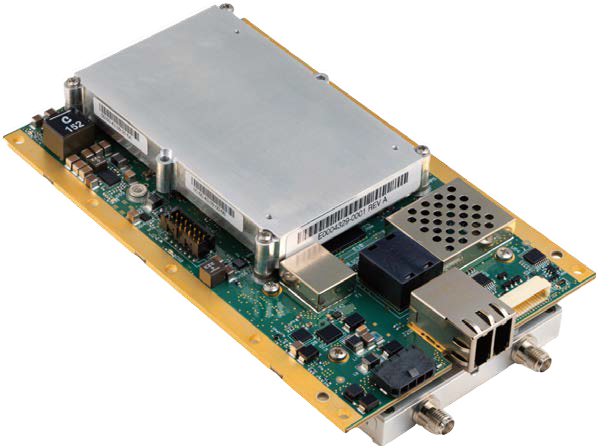Ringing in the new year brings with it refreshing ideas, anticipation, hope for the future, and predictions. For military satellite communications (MILSATCOM), the top 2024 trends and predictions center around resiliency, security and technological innovations.
With the world currently seeming to be in disarray, the need for reliable and viable military satellite communications has rarely been as crucially important to our nation and our allies as today. Here’s an iDirect Government (iDirectGov) look at the key MILSATCOM trends in 2024 and what’s ahead to help defend our freedoms and interests.

Security
Protecting the country’s MILSATCOM networks from emerging threats is critical to the U.S. government. In 2024, there will be a continued and an increased focus on security and resiliency. A multi-layered, reliable, and resilient environment is paramount to deliver secure satellite transmissions to military users — anywhere and at anytime.
The MILSATCOM security technologies of today must provide a multi-layered and resilient solution. Tools such as transmission security (TRANSEC), communications security (COMSEC), and advanced anti-jam capabilities such as Communications Signal Interference Removal™ (CSIR™) are becoming essential “must-haves” to ensure proper protection for data, voice as well as video transport.
These capabilities coupled with military standards such as — NIST Federal Information Processing Standard (FIPS)140-2, Level 3, Security Content Automation Protocol (SCAP), MIL-STD 810G, DO-160G — all increase the resiliency of communication and data networks.
As cyber-attacks, electronic warfare (EW), and other intentional and unintentional jamming occur, countermeasure technology will be developed to solve these challenges. SATCOM platforms will have increased jamming protection to combat both blue-on-blue and red-on-blue radio frequency (RF) interference.
Multi-Orbit, Multi-Waveform Technology
The rise of multi-orbit and multi-waveform technology is translating into single platform, multi-mission capabilities. Some Department of Defense (DoD) missions require low latency and can use LEO/MEO-based satellite networks that support low latency missions. Other defense missions require more broadcast communications capacity where latency is not as important and, therefore, warfighters can access GEO SATCOM capabilities.
Additionally, a single defense-based platform that can serve multi-orbit networks will provide redundancy, should a network be offline for any reason. In this case, the iDirect Government single platform enables the warfighter to seamlessly switch to another operating network, providing redundancy.
In 2024, multi-orbit and multi-waveform capabilities will continue to mature. Integration and interoperability in the ground segment will start to take center stage in providing open architecture attributes that allow the warfighter to access various MILSATCOM network solutions.
Software-Defined Radio (SDR)
Building on our momentum with the recent launch of the Revolution 450mp (man-portable) software-defined radio (SDR) modem--and the Evolution Defense 4.6 platform — on which the 450mp operates — iDirect Government will continue to build on these highly reliable solutions.

The 450mp SDR modem.
The 450mp is the first 4-Series SDR, introduced with the new Evolution Defense 4.6 software. The Evolution Defense 4.6 platform incorporates improved security, including flexible key exchange for crypto agility, strengthened TRANSEC, and augmented CSIR technology. Additionally, the 450mp SDR will support multi-orbit and multi-waveform capabilities.
The potential flexibility and interoperability features with the 450mp SDR will provide the government end users with options for growth and future development. Not only will this yield continual operational improvements, but it will also provide an element of capital protection.
Artificial Intelligence
Artificial Intelligence (AI) will continue to make inroads in SATCOM in 2024. In the years to come, we will see organic, demand-base, satellite network access, dynamic bandwidth allocation and greater automation in SATCOM networks.
With regard to resiliency, AI and Machine Learning (ML) will also assist in the determination of a jamming and/or interference evolution and the implementation of an appropriate solution. SATCOM networks will eventually “learn” how to defend themselves against complex security threats.
However, just as AI can be used in the battlefield by our friends and Allies, the warfighter may encounter adversaries who use AI to widen the attack surface at the tactical edge. AI can be seen as both a tool and a weapon. There is no question that the battlefield of the future will include AI-powered solutions.
Commercial-Off-The-Shelf (COTS) + Standards
The DoD should continue to leverage COTS technology when and where able. With COTS and the industry agreeing upon standards, there are increased options for interoperability and seamless operations. Additionally, when considering the speed of development and adoption, commercially available technology can be highly advantageous.

We’re seeing this unfold in a few ways. First, these solutions are available to the defense community on a faster timeline than custom developments. Cooperation with the DoD on a COTS solution benefits both the DoD and the vendor community. The DoD can leverage available COTS technology without waiting for new solutions to be developed and tested for reliability.
Second, implementing COTS solutions that are field proven usually saves the DoD monetary outlays for new technology.
However, to meet the security requirements of the DoD end user, advanced security features to enable robust MILSATCOM networks for the warfighter must be implemented within COTS hardware. These features are usually specialized, must be “military grade” and include advanced capabilities to include anti-jam, low probability of detection and other resiliency focused elements.
Going forward, security needs to be at the forefront of any development and design activity. MILSATCOM networks must be secure and able to operate in complex, contested environments.
Ahead For 2024
In 2024, iDirect Government’s focus will be on incorporating multi-mission, multi-waveform and multi-orbit technology into our next-generation platform.
The industry will continue to develop multi-orbit, dynamic capabilities to support advanced mobility requirements and operational efficiencies for the warfighter. Resiliency and security will be necessary for all next generation networks, platforms and ecosystems.
The market can continue to expect innovative solutions from iDirectGov. Our ever-evolving product portfolio and enhancements will bring security, flexibility, agility, and efficiency to warfighters, first responders, disaster recovery personnel, and field operators.
In Perspective
Specialized innovation and solid investments in secure solutions are ahead as we negotiate the connectivity pathways. This is a specialized process that does not end in 2024 but will continue well into the future.
www.idirectgov.com

Author Tim Winter is President of iDirect Government. Winter oversees the corporate strategy and leads the iDirectGov team to bring solutions to military SATCOM (MILSATCOM). He brings more than 20 years of experience in the satellite communications arena. Prior to joining iDirect Government, Winter served as Vice President of Global Accounts and Global Government and Defense at parent company ST Engineering iDirect. Winter managed all strategic global account engagements and capture pursuits for International Defense opportunities. Winter served in the U.S. Navy and flew P-3 Orion aircraft as a Naval flight officer on active duty for eight years. He continued his service in the United States Navy Reserves, flying P-3 aircraft and the BAMS-D UAV through 2022. He recently retired from the U.S. Navy with the rank of commander.


